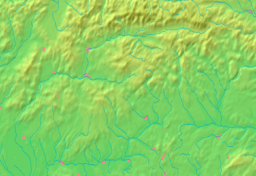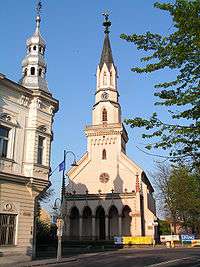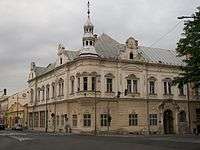Lučenec
| Lučenec | ||
| Town | ||
.jpg) Panorama of Lučenec | ||
|
||
| Country | Slovakia | |
|---|---|---|
| Region | Banská Bystrica | |
| District | Lučenec | |
| Tourism region | Novohrad | |
| Elevation | 190 m (623 ft) | |
| Coordinates | SK 48°19′43″N 19°40′09″E / 48.32861°N 19.66917°ECoordinates: SK 48°19′43″N 19°40′09″E / 48.32861°N 19.66917°E | |
| Area | 47.791 km2 (18 sq mi) | |
| Population | 28,508 (31 December 2011) | |
| Density | 597/km2 (1,546/sq mi) | |
| First mentioned | 1247 | |
| Mayor | Alexandra Pivková | |
| Timezone | CET (UTC+1) | |
| - summer (DST) | CEST (UTC+2) | |
| Postal code | 98401 | |
| Phone prefix | 421-47 | |
| Car plate | LC | |
  Location in Slovakia | ||
  Location in the Banská Bystrica Region | ||
| Wikimedia Commons: Lučenec | ||
| Statistics: MOŠ/MIS | ||
| Website: http://www.lucenec.sk | ||
Lučenec (Slovak pronunciation: [ˈlutʃeɲets]; German: Lizenz; Hungarian: Losonc; Yiddish: לאשאנץ; Latin: Lutetia Hungarorum[1]) is a town in the Banská Bystrica Region of south-central Slovakia. Historically, it was part, and in the 18th century the capital, of Nógrád County of the Kingdom of Hungary. In 1918, as a result of the Treaty of Trianon, it became a part of Czechoslovakia. The town has a large synagogue, built in 1924, which served a large Jewish population before World War II. The synagogue underwent renovations in 2016.
Lučenec is the economic centre of the whole Novohrad region, which includes districts Poltár and Veľký Krtíš.
History
Lučenec and its surroundings were inhabited in the Stone Ages. Slavs moved to this area in the 6th and 7th century as the first permanent settlers and the Hungarians joined them in the 10th century.
The first indirect mention of Lučenec was in 1128, when Lambert built a chapel in honour of Virgin Mary. The first direct mention of the settlement was in 1247 under the name Luchunch, but until the first half of the 15th century it was only a village, and was located off the main trade routes. In 1442, Lučenec was conquered by the Hussites troops under command of John Jiskra of Brandýs and in 1451 the Battle of Lučenec took place near the village between the troops of John Hunyadi and those of Jiskra, where the latter emerged victorious.
After the fall of the Fiľakovo (Hungarian: Fülek, German: Fülleck) castle in 1554, Lučenec was under the control of the Ottomans and their vassals as part of Budin Eyalet until capturing by Austrians in 1593. It was regained by Ottomans in 1596 and was again part of Filek (Ottoman name for Filakovo) sanjak (Its centre was Rima Sonbot) in Eğri Eyalet till 1686. The town was burned down many times until the first half of the 19th century, when during the Revolutions of 1848/1849 it was occupied by the Russian imperial troops.
The town underwent modernization in the 19th and 20th centuries, for example, new industries like brickworks or tanneries were built, telegraph line in 1865, and in 1871 it was connected to the railway connecting Budapest (Slovak: Budapešť) and Žilina (Hungarian: Zsolna, German: Sillein). After World War I, Lučenec became part of Czechoslovakia, and, briefly in 1919, part of the Slovak Soviet Republic. In 1938, Lučenec was annexed to Hungary as a result of the First Vienna Award, and this lasted until 1945 when it was returned to Czechoslovakia. Nowadays: 8,3% of Hungarians live in town.
Climate
Lučenec has a continental climate with four alternating seasons. It means hot summers and cold winters. There is high amount sunshine days with short time of duration of snow cover as well as the cover is relatively low. Near by Lučenec are located several water reservoirs such as Ľadovo, Mýtna, Málinec and most popular Ružiná.
| Climate data for Lučenec | |||||||||||||
|---|---|---|---|---|---|---|---|---|---|---|---|---|---|
| Month | Jan | Feb | Mar | Apr | May | Jun | Jul | Aug | Sep | Oct | Nov | Dec | Year |
| Average high °C | 0.9 | 4.3 | 10.1 | 15.8 | 21.1 | 24 | 26.2 | 26.3 | 21.4 | 14.9 | 6.7 | 2.1 | 14.48 |
| Average low °C | −6 | −4.3 | −0.6 | 3.5 | 8.3 | 11.3 | 12.8 | 12.4 | 8.8 | 4.1 | −0.2 | −3.9 | 3.85 |
| Average high °F | 33.6 | 39.7 | 50.2 | 60.4 | 70 | 75 | 79.2 | 79.3 | 70.5 | 58.8 | 44.1 | 35.8 | 58.05 |
| Average low °F | 21 | 24.3 | 30.9 | 38.3 | 46.9 | 52.3 | 55 | 54.3 | 47.8 | 39.4 | 31.6 | 25 | 38.9 |
| Source #1: | |||||||||||||
| Source #2: | |||||||||||||
Demographics
From 28,475 inhabitants (census 2011) are
- Slovaks - 18,383 65,6%
- Hungarians - 2,371 8,3%
- others - 7,721 - 27,1%
In 1910 out of 12,939 inhabitants 10,634 were Hungarians (82%), 1,675 Slovaks (13%), 428 Germans, 9 Romas, 1 Ruthenian, 12 Croatians, 18 Serbans and 162 others.
According to the 2001 census, there were 28,332 people living in the town, with majority of them being Slovaks (81.63%), with a minority of Hungarians (13.11%) and with a small percentage of Roma (2.32%), Czechs (0.61%) and others. The religious make-up was: 56.56% Roman Catholics, 21.12% people with no religious affiliation and 14.77% Lutherans.[2]
Boroughs
Lučenec is divided into these boroughs:
- Lučenec
- Opatová
- Malá Ves
- Rúbanisko
People
- Timrava (Božena Slančíková) (1867–1951)
- Ivan Saktor (b. 1954) (Slovak)
- Tibor Serly, Hungarian classical composer
- Sándor Petőfi (1823–1849), Hungarian poet
Twin towns – Sister cities
Lučenec is twinned with the following:
Gallery
 The Reformed church, built in 1853
The Reformed church, built in 1853 The Roman Catholic church
The Roman Catholic church.jpg) Synagogue in Lučenec
Synagogue in Lučenec Novohrad library in Lučenec
Novohrad library in Lučenec The Tuhár brook in Lučenec
The Tuhár brook in Lučenec.jpg) City Park in Lučenec
City Park in Lučenec
References
- ↑ Lelkes György (1992), Magyar helységnév-azonosító szótár, Balassi Kiadó, Budapest, 508 p.
- ↑ "Municipal Statistics". Statistical Office of the Slovak republic. Archived from the original on 2008-01-11. Retrieved 2008-01-13.
